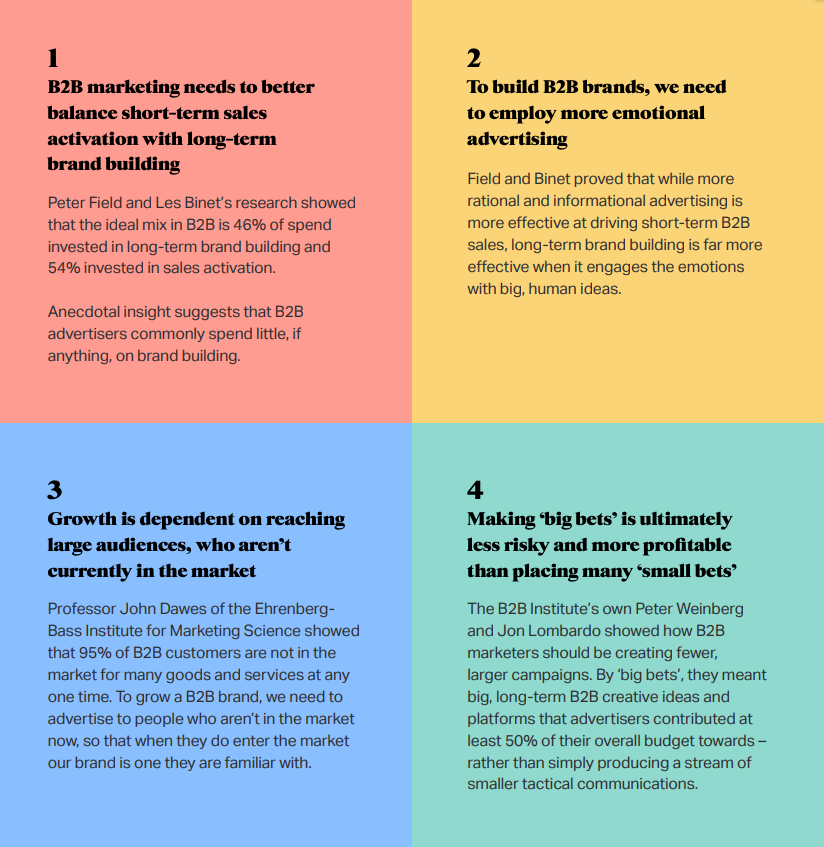B2B marketing – Let’s get emotional and creative
LinkedIn’s B2B Institute report, “The B2B Effectiveness Code,” shows that 95% of B2B buyers are not currently in the market for many of the products or services available. However, much of the marketing done today is designed only to capture the demand of those seeking a solution right now. That means we’re only chasing 5% of potential B2B buyers at any given time! Is it a wonder then that we tend to be disappointed in the results we see from short-term campaigns and programs?
In one of my previous blogs, I talked about how marketing must be a long-game investment. Yet in so many instances, it’s treated as a short-term means to drive revenue and thus, the strategy and tactics used don’t support a long-game. What should we be doing instead?
Brand affinity vs brand awareness
Building brand affinity is key for this. Some would say its synonymous with brand awareness but there is a nuanced difference. Affinity, by definition, means a natural liking for some thing (person, thing, idea, product, service, etc.). For those companies that I work with, I strive to create affinity because it puts you a step above the others. I also want my client’s customers to be more than aware of the brand I’m helping to build; I want them to want to work with the company I support.
This is all about creating a sense of trust, not dissimilar to a person courting another person. Trust is a foundation for more than just romantic or platonic relationships, it’s imperative for companies that work wth customers (i.e. SMBs, enterprise, etc.).
B2C companies do this quite well already and there’s a lot that we can learn from them in B2B. Yes, there are fundamental differences but if we believe that we can’t learn from each other, then how will we get better, improve our work, be open to change, and make that change happen? So, what can we learn from B2C right now and how do we implement it?
Emotional creativity?
There are two things that B2B companies tend to shy away from:
Emotion
Creativity
Coke released a commercial over the Thanksgiving season, showing a grandson making dinner for his family and not doing a great job of it. But, he powered through with a helping hand from the essence of his grandmother. At the end, we see him toasting a picture of his grandmother while drinking a Coke and eating the dinner he lovingly prepared with his family. The commercial invokes feelings of love, comfort, sadness for his loss, and memories of someone special who taught him what he knows, and, of course, loved Coke.
Now, this kind of emotion may not be right for every B2B company. But, we as humans have so many emotions: pride, amusement, relief, interest, joy, surprise, satisfaction, and others that can be applied. Coupling emotion with creativity (to get their attention) allows us to tap into the “feeling” side of the human buyer behind the façade of the business we’re marketing to.
Source: LinkedIn: B2B Institute report, “The B2B Effectiveness Code”
Back to the 95% stat mentioned at the start of this article. Repeated messages coming from a B2B company that use emotion and creativity to create brand affinity will lay the groundwork needed to shepherd those future buyers onto your customer list. This audience must be primed so that when they are ready to buy, they turn to you.
This requires investment into marketing’s long-game status, placing bets on the funnel of the future, and stepping outside your comfort zone. Just because your product may be technical in nature or has a technical buyer, those buyers are all human at their base. And if you’re not willing to go all-in with this strategy, I get it, it can be scary. But do set aside budget and time (time is key here!) to experiment with it. See what works over a few months and then lean into the one that is working best.
If you have any questions about this blog or want to talk about your marketing needs, please send me an email at rosa@rosalear.com or fill out my contact form, I’ll be happy to speak with you.


